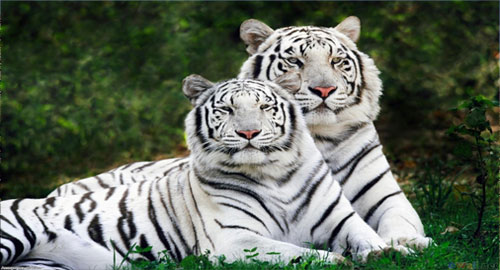|
|||||||||||||||
|
|||||||||||||||
BENGAL TIGER
HABITATThe Bengal tiger is most numerous in the mangrove forests of the Sundarbans in eastern India and Bangladesh where the River Ganges meets the Bay of Bengal. They are also found in other areas of India as well as some parts of Nepal and Burma.Since Bengal tigers are solitary and do not like to share their hunting grounds, they need large home ranges in which to hunt. Males occupy about 20 square miles, while females typically require 17 square miles. A tiger usually has several dens in its home range and uses whichever one is most convenient at the time. BREEDINGBengal tigers usually breed in the spring. A neighboring male meets with a female in her home range. For 20-80 days he remains with her, she is fertile for only 3-7 days. After mating, the male returns to his home range and plays no part in rearing the cubs.Approximately 15 weeks later, the tigress gives birth to two to four cubs. She suckles them for 8 weeks, after which she brings them prey to eat as well. At 11 months, the cubs can hunt on their own. The tiger cubs stay with their mother for 2-3 years, at which time she is ready to mate again. FOOD & HUNTINGBengal tigers are nocturnal : they hunt at night. Though powerful and quick over short distances, they stalk their prey because they cannot outrun faster prey. The tiger kills small prey with a bite on the back of the neck and large prey with a bite to the throat.Tigers mainly hunt gaur (wild ox) and buffalo. Although a tiger is capable of killing a bull gaur more than twice its size, it prefers to attack young or old animals that put up less resistance. In the Sundarbans region of India and Bangladesh, the tiger's prey are chital (axis deer), wild boar, and monkeys. Tigers will sometimes attack porcupines. KEY FACTSSize» Length : Males, 9-10 ft., head to tip to tail. » Shoulder height : 36 in. » Weight : Male 400-575 lb. Breeding » Sexual maturity : 3-4 years. » Mating : Usually in spring. » Gestation : 95-112 days. » Litter size : 2-4 cubs. Lifestyle » Habit : Solitary and nocturnal. » Diet : Chital, wild boar, monkeys, gaur, buffalo. » Call : Roar, growl, or purr. » Lifespan : 15 years under normal conditions. DID YOU KNOW ?
|
| Corporate Information | Partner with Us | Customer Care | Top Destination | Top Deals | ||||||||||
| About Us | Hotels in India | FAQ | Goa Tours | Goa Tour Packages | ||||||||||
| Our Team | Become a Affiliate | Contact Us | Rajasthan Tours | North India Tour Packages | ||||||||||
| Make My Trip Planner | Register your Hotel | Himachal Pradesh | Honeymoon Tour Packages | |||||||||||
| Board of Directors | Advertise with Us | Kerala Tour | Adventure tours India | |||||||||||
| Blog | Career | Pilgrimage Tours | Golden Triangle Tour | |||||||||||
| Holidays Packages India | Useful Links | All Destinations | North East India Tour Packages | |||||||||||









 The Bengal tiger's characteristic reddish gold fur and black stripes are easily visible to visitors in a zoo. But in the tiger's natural habitat of forest and reed beds, the markings act as camouflage and enable it to disappear from view.
The Bengal tiger's characteristic reddish gold fur and black stripes are easily visible to visitors in a zoo. But in the tiger's natural habitat of forest and reed beds, the markings act as camouflage and enable it to disappear from view.